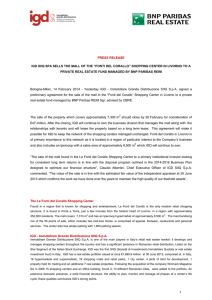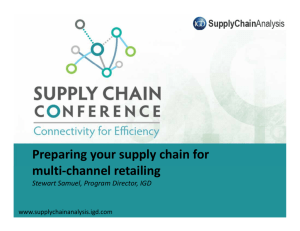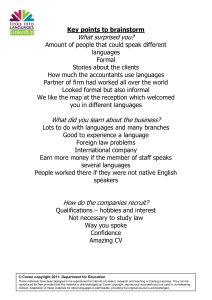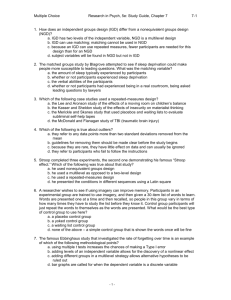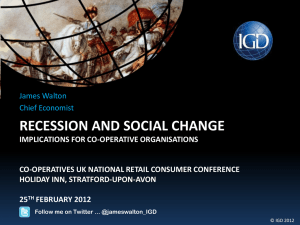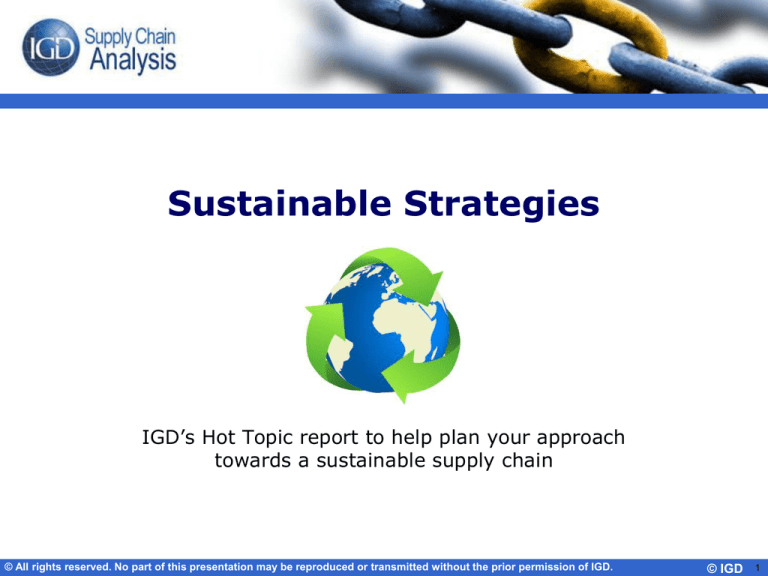
Sustainable Strategies
IGD’s Hot Topic report to help plan your approach
towards a sustainable supply chain
© All rights reserved. No part of this presentation may be reproduced or transmitted without the prior permission of IGD.
© IGD
1
To get the most out of this Report
•
Each slide in this report is
accompanied with written
commentary
•
This commentary can be viewed in
the Slide Notes
•
To do this go to the View Menu
and select ‘Notes Page’
•
To print the slides with
commentary, ensure you are
printing the Notes pages
© All rights reserved. No part of this presentation may be reproduced or transmitted without the prior permission of IGD.
© IGD
2
About this Report
•
Why should you look at sustainability now?
•
Carbon & Energy Management
•
Packaging & Waste Management
•
Distribution Optimisation
•
Sourcing & Supplier Engagement
•
Preparing your plan to meet future needs
– What does sustainability include, industry initiatives & the priorities
– Performance measures, KPIs, industry initiatives, best practice examples, supply
chain implications
– The waste hierarchy, closing the packaging loop, KPIs, industry initiatives,
examples, supply chain implications
– KPIs, industry initiatives, best practice examples, improvement initiatives,
supply chain implications
– KPIs, industry initiatives, best practice examples, supply chain implications
© All rights reserved. No part of this presentation may be reproduced or transmitted without the prior permission of IGD.
© IGD
3
IGD’s Research on Sustainable Strategies
•
Online poll of senior retailer and supplier executives
– 134 companies in 24 countries including 15 European countries
•
Survey of senior supply chain professionals
– 66 companies in 10 European countries including the UK
•
Over 20 in-depth interviews with senior retailer and supplier executives
and industry experts in Europe and the US
•
Detailed analysis of CSR reports of the top 20 retailers from IGD’s Global
Retail Index
•
Analysis of the outputs from ECR UK & ECR Europe workgroups in the
areas of sustainable distribution & packaging
© All rights reserved. No part of this presentation may be reproduced or transmitted without the prior permission of IGD.
© IGD
4
Why should you look at sustainability now?
•
Concerns over environmental degradation, resource exploitation
and general business durability
•
There are a number of supplementary reasons why sustainability
has become more important. These are:
Commercial/pragmatic considerations
Ethical/ idealistic considerations
•
Cost reduction
•
Political activism
•
Alignment with evolving consumer
requirements
•
Economic/ ethnic/ religious favouritism
•
Potential for increased shareholder value
•
Employee relations
•
Protecting and developing the brand
•
Safeguarding future business
© All rights reserved. No part of this presentation may be reproduced or transmitted without the prior permission of IGD.
© IGD
5
Sustainability is rising up the commercial agenda
“There is a real change in terms of sustainability not being solely a
corporate function but now filtering through the commercial and marketing
functions. This is a new way of doing business”.
“At first our buyers thought sustainability was a fad. However, measuring
carbon footprints is built into the bonus system of all our senior managers
so they had little choice but to participate”.
“Consumers increasingly expect leading brands to do their share towards
environmental and social issues”.
Senior Executives, Multinational Suppliers
Source: IGD International Sustainability Survey, May 2008
© All rights reserved. No part of this presentation may be reproduced or transmitted without the prior permission of IGD.
© IGD
6
Sustainability is an opportunity to differentiate
What are the influences that have shaped your company’s strategy on
sustainability?
Building a positive corporate image
7.8
Need for better customer engagement
7.3
Opportunity to differentiate
7.2
Potential cost savings
7.2
Innovation in products & processes
7.0
Beliefs of management team
6.8
Legislative compliance
6.4
Shopper demand for ethical products
6.1
5
Scale: 1 = least important, 10 = most important
Source: IGD International Sustainability Survey, May 2008
6
Average Rating
7
© All rights reserved. No part of this presentation may be reproduced or transmitted without the prior permission of IGD.
8
© IGD
7
What does sustainability include?
ENERGY
WASTE
DISTRIBUTION
WATER
SOCIAL
•Energy efficiency
•Food & material
•Road transport
•Water sourcing
•Sustainable &
•Refrigeration
waste
optimisation
•Water usage
ethical sourcing
•Renewable energy
•Packaging
•Warehousing
•Embedded water
•Health & nutrition
optimisation &
•Alternative modes of
innovation
transport to road
•Community
•Recycling
Source: www.igd.com/sustainability
© All rights reserved. No part of this presentation may be reproduced or transmitted without the prior permission of IGD.
© IGD
8
Sustainability: a long-term journey
Source: IGD Research, 2008
© All rights reserved. No part of this presentation may be reproduced or transmitted without the prior permission of IGD.
© IGD
9
Industry initiatives & priorities
NOW
NEXT 2-3 YEARS
1.
Energy reduction
1.
Energy reduction
2.
Waste reduction
2.
Packaging reduction
3.
Packaging reduction
3.
Carbon measurement
4.
Transport optimisation
4.
Waste reduction
5.
Carbon measurement
5.
Transport optimisation
6.
Water management
6.
Sustainable sourcing
7.
Sustainable sourcing
7.
Water management
8.
Ethical sourcing
8.
Ethical sourcing
9.
Eco-design of products
9.
Eco-design of products
Source: IGD International Sustainability Survey, May 2008
© All rights reserved. No part of this presentation may be reproduced or transmitted without the prior permission of IGD.
© IGD
10
Carbon & Energy Management are fundamental
•
Retailers are investing in new technologies across the supply chain and collaborating
with manufacturers' to drive change
•
The most advanced retailers in this area have made environmental initiatives central
to their corporate strategy
•
The focus of these retailers is to:
– Limit the environmental impact of their own businesses
– Engage with suppliers to drive change across the wider supply chain, and
– Build this into their communication strategy to gain a competitive advantage
© All rights reserved. No part of this presentation may be reproduced or transmitted without the prior permission of IGD.
© IGD
11
Carbon & Energy – what is being measured?
• Leading retailers in the UK & Europe are focusing on limiting their
own energy consumption & carbon emissions
• Typical measures include
– Energy consumption per case sold/ per sqm
– Electricity usage in facilities
– Greenhouse gas emissions from refrigerants’ loss
– Meeting energy standards for buildings
– Share of energy from renewable sources
© All rights reserved. No part of this presentation may be reproduced or transmitted without the prior permission of IGD.
© IGD
12
Global retailers – Carbon & Energy KPIs
Retailer
Key Performance Indicators
•
•
Establish a Greenhouse Gas (GHG) Network to study and actively reduce its carbon
footprint
Be supplied 100% by renewable energy
Make new stores 25-30% more efficient by 2009 & existing stores 20% more efficient by
2012
Reduce water consumption
•
•
•
•
Carbon emission in tonnes, and per shipping unit (kg)
Energy consumption per sqm
Refrigerant consumption/ sales area (kg/1,000 sqm)
Water consumption in thousand cubic metres and per sqm
•
•
•
Reduce carbon emissions from existing stores and distribution centres worldwide by at
least 50% by 2020
Reduce energy consumption per square foot by 10% by 2010 as part of a long-term
commitment to reduce energy use by 50%
Reduce its water consumption per square metre by at least 2% compared with 2006
Work with SCI (Sustainable Consumption Institute) to investigate biofuels
•
•
•
•
Extend the collection of key environmental figures to all Metro companies by 2010
Raise energy efficiency in its business operations
Develop guidelines for the application of coolants
Reduce fresh water consumed per square metre
•
•
•
Source: IGD Research, 2008
© All rights reserved. No part of this presentation may be reproduced or transmitted without the prior permission of IGD.
© IGD
13
Carbon & Energy – Industry Initiatives
High
Level of adoption
Low
High
Carbon offsetting
Ease of implementation
Low
High efficiency refrigeration equipment Geothermal systems
Minimising wastewater discharge
Reduced air conditioning
Cold/ hot air retrieval systems
Motion activated light sensors Alternative refrigerants
Reducing refrigerants leakage
Carbon measurement of stores &
warehouses
Rainwater harvesting
Carbon measurement of
products (on a test basis)
Low energy lighting
Solar panels
Adding doors to fridges and
freezers
Low water use appliances and
housekeeping
Wind turbines
© All rights reserved. No part of this presentation may be reproduced or transmitted without the prior permission of IGD.
© IGD
14
What are other leading retailers’ key focus areas?
• Making ongoing improvements in energy efficiency
• Increasing the use of renewable sources of energy
• Reducing the emissions and energy consumption per case sold
year-on-year
• Setting carbon targets for stores and other operations
• Reducing the consumption of water and the contamination of
waste waters
© All rights reserved. No part of this presentation may be reproduced or transmitted without the prior permission of IGD.
© IGD
15
Eco-design & carbon labelling – Industry Initiatives
High
Ease of implementation
Sustainable criteria in PL
tenders
Carbon labelling (on a test
basis)
Selling environmentally friendly
products such as products made
from alternative fibres
Low
Level of adoption
High
Low
Selling environmentally
friendly products such as
home composting solutions
Energy-saving products
e.g. light-bulbs
Consumer education – e.g.
leaflets, website
Concentrated products
Detergent and household
product modification
Design changes for electrical
products
© All rights reserved. No part of this presentation may be reproduced or transmitted without the prior permission of IGD.
© IGD
16
Eco-design: what are other leading retailers’ focus areas?
• Promoting products that are good for the environment
• Minimising air transport while helping trade with developing
economies
• Increasing the range of energy-efficient product ranges sold
• Helping customers choose energy efficient products
• Supporting the development of a methodology to measure
embedded carbon within products and piloting carbon labels
© All rights reserved. No part of this presentation may be reproduced or transmitted without the prior permission of IGD.
© IGD
17
Best Practice – Carbon & Energy
Source: IGD Research, Company websites, 2008
© All rights reserved. No part of this presentation may be reproduced or transmitted without the prior permission of IGD.
© IGD
18
Supply Chain Implications
• The food supply chain will be expected to lead the way in reducing
greenhouse gas emissions
• Increasingly, savings from energy efficiency & use of alternate
sources of energy will gain strategic importance
• There will be greater focus and need for carbon measurement of
the entire supply chain
• The supply chain will need to move from ‘quick wins’ to reduce
energy consumption to looking at more structural changes to their
operations
© All rights reserved. No part of this presentation may be reproduced or transmitted without the prior permission of IGD.
© IGD
19
Packaging & Waste – what are industry priorities?
• Packaging reduction continues to be a key initiative, with a trend
towards
– Reduction in volume & weight of packaging
– Increased sourcing of sustainable materials
– Further use of recycled material
• Retailers are engaging with suppliers to reduce waste generated
at source by:
– Managing the waste hierarchy
– Closing the packaging loop
© All rights reserved. No part of this presentation may be reproduced or transmitted without the prior permission of IGD.
© IGD
20
Global Retailers – Packaging & Waste KPIs
Retailer
Key Performance Indicators
•
•
•
•
Reduce overall packaging by 5% by 2013 & become packaging neutral by 2025
Replace PVC (polyvinyl chloride) in own label packaging
Zero waste in all Wal-Mart and Sam's Club stores by 2025
Reduce solid waste from U.S. stores and Sam’s Clubs by 25% by October 2008
•
•
•
Reduce packaging by 10% by 2013
Increase recyclable content in packaging by 75%
Waste recycled in tonnes and per sales area (kg/sqm.)
•
Reduce the weight of packaging on branded and Tesco own-label products by 25%
by 2010
Divert 75% of waste from landfill, as part of a long-term commitment to divert
80% between 2006/07 and 2008/09
Where recycling units are present, double customer recycling by 2008 relative to
2006 levels
Reduce carrier bags given out by 50% by February 2009 vs. May 2006
•
•
•
•
•
•
•
Minimise the packaging of own brand products
Maintain the current levels of waste generation and recycling of 93% for German
operations
Reduce waste produced by other locations beyond Germany by at least 5%
Increase recycling levels in countries outside Germany from 64% to at least 67%
Source: IGD Research, 2008
© All rights reserved. No part of this presentation may be reproduced or transmitted without the prior permission of IGD.
© IGD
21
What are other leading retailers’ focus areas?
• Increasing the amount of packaging made from sustainable
materials and its recycled /recyclability
• Reducing food waste and recycling, composting or using the waste
as input for anaerobic digestion
• Extending the scope of packaging reduction agreements with
suppliers
• Controlling cost of waste management
• Setting specific operational standards for measuring waste
© All rights reserved. No part of this presentation may be reproduced or transmitted without the prior permission of IGD.
© IGD
22
Packaging & Waste – Industry Initiatives
High
Food waste sent for
composting
Using packaging scorecards
with suppliers
Low
Level of adoption
High
Ease of implementation
Low
Issuing packaging
guidelines to suppliers
Local community partnership
e.g. schools
Using recycled print material
Reusable secondary packaging Using new types of
Closed loop recycling schemes sustainable or recycled
materials (test basis)
(test basis)
Compostable or
degradable packaging
(test basis)
Recyclability information on PL
packaging
Carrier bag recycling or
charging
Recycling points at store
Back-office store recycling
schemes
Reduced volume packaging
e.g. concentrated/ refillable
© All rights reserved. No part of this presentation may be reproduced or transmitted without the prior permission of IGD.
© IGD
23
The Waste Hierarchy
Source: IGD Research, 2008
© All rights reserved. No part of this presentation may be reproduced or transmitted without the prior permission of IGD.
© IGD
24
Closing the Packaging Loop
Packaging
Cycles
Primary
Secondary
Manufacture
Filling
Compost
Recycle
Return /
Reuse
Incineration
or Landfill
Extraction
Tertiary
Distribution
Retail
Home
Source: IGD Research, 2008
© All rights reserved. No part of this presentation may be reproduced or transmitted without the prior permission of IGD.
© IGD
25
Source: IGD Research, Company websites, 2008
Examples of RRP: Reducing Primary and Overall Packaging
© All rights reserved. No part of this presentation may be reproduced or transmitted without the prior permission of IGD.
© IGD
26
New shipper case: more efficient & environmentally friendly
USA / Macaroni & Cheese
2007
Count:
Pack:
Pallet Configuration:
2008
48 cartons
6 across X 8 deep
8 cases/layer;
80 cases/pallet
Benefits
Easy open / Less labor
Eliminate overhang
Count:
Pack:
Pallet Configuration:
Printed case
Reduced case count
35 cartons
5 across X 7 deep
9 cases/layer;
90 cases/pallet
Reduces corrugate
by 20%
© All rights reserved. No part of this presentation may be reproduced or transmitted without the prior permission of IGD.
© IGD
27
Germany / Central Europe Jacobs Coffee SRP tray
facilitates in-store handling with minimal outer packaging waste
Corrugate tray
– No hood
– No wrap
Source: IGD Research, Company websites, 2008
© All rights reserved. No part of this presentation may be reproduced or transmitted without the prior permission of IGD.
© IGD
28
Supply Chain Implications
•
Regulation will focus on the issue of food-waste and portion size; retailers
will continue to engage with suppliers to reduce waste
•
Simplification (and the integration) of primary, secondary and tertiary
packaging will lead to a shift in warehousing and transport strategies
•
Closed loop packaging will gain traction and will become important in the
movement of ‘consumables’
•
With the increasing use of recycled plastic, standardisation of acceptable
materials is likely
•
Development of alternative types of packaging, packaging materials and
systems will create new opportunities and challenges
© All rights reserved. No part of this presentation may be reproduced or transmitted without the prior permission of IGD.
© IGD
29
Distribution – what are industry priorities?
• Transport & warehousing are visible parts of the food supply chain
and key to supporting and delivering against the CSR agenda
• Major industry initiatives in this area include:
– Improving space utilisation and fuel usage
– Optimising road transport, including vehicle design, engine type, fuel
type
– Building and retro-fitting warehouse facilities to improve sustainability
– Developing alternate non-road transport modes (rail, canals)
© All rights reserved. No part of this presentation may be reproduced or transmitted without the prior permission of IGD.
© IGD
30
Global Retailers – Transport & Distribution KPIs
Retailer
Key Performance Indicators
•
•
Make distribution fleet 25% more efficient in three years
Make distribution fleet 100% more efficient in 10 years compared to current
levels
•
Implementation of central distribution in a country
•
Reduce the amount of CO2 produced in the distribution network per case
delivered by 8% by 2008 and by 50% between 2006 – 2012
Restrict air transport to less than 1% of their products
Improve efficiency in the distribution network through more efficient transport
methods
•
•
•
Change the entire truck fleet to vehicles that comply with Euro 5 Standard by
late 2009
Source: IGD Research, 2008
© All rights reserved. No part of this presentation may be reproduced or transmitted without the prior permission of IGD.
© IGD
31
What are other leading retailers focusing on?
• Increasing the use of bio-diesel in own fleet operations
• Introducing a ‘green’ travel policy to reduce carbon emission
caused by travel
• Replacing fleet with vehicles that meet Euro 4 & Euro 5 emissions
standards
• Using battery operated vehicles for online shopping deliveries
© All rights reserved. No part of this presentation may be reproduced or transmitted without the prior permission of IGD.
© IGD
32
Transport – Industry Initiatives
High
Level of adoption
Low
High
Vehicle telematics*
Driver training
Vehicle maintainance
Vehicle utilisation
Ease of implementation
Low
Out of hours deliveries*
Transport collaboration*
Logistics system redesign*
Modern engine design*
Trailer design
Larger vehicles*
Alternative fuels -natural gas
Alternative fuels - Bio-fuels
Alternative fuels - Electricity
Hybrid/ parallel hybrid
(all often on a test basis)
Modal shift/ inter modality
(test)
* Areas explored as part of IGD Research
© All rights reserved. No part of this presentation may be reproduced or transmitted without the prior permission of IGD.
© IGD
33
Best Practice - Sustainable Transport
Source: IGD Research, Company websites, 2008
© All rights reserved. No part of this presentation may be reproduced or transmitted without the prior permission of IGD.
© IGD
34
Technical improvements lead the way
Logistics system redesign
76%
Vehicle telematics
74%
Modern engine design
71%
Transport collaboration
71%
69%
Out of hours deliveries
56%
Larger vehicles
0
20
40
60
80
% mentioning already in use, under development or planned for the
future
Source: IGD Research, 2008
© All rights reserved. No part of this presentation may be reproduced or transmitted without the prior permission of IGD.
© IGD
35
Warehousing – Industry Initiatives
Ease of implementation
High
High
Level of adoption
Low
Rainwater harvesting*
Low water use appliances*
Low
Timber from sustainable sources
Green roofs
Recycled building materials
Reclaimed building materials
Recycled floor coverings
On site energy generation (wind,
solar)*
Geothermal heating and cooling*
Sun shading and insulation
Air tightness & use of inner
and outer doors
Energy efficient lighting*
Housekeeping practices to
save energy
On site recycling*
* Key initiatives identified by ECR UK workgroup
© All rights reserved. No part of this presentation may be reproduced or transmitted without the prior permission of IGD.
© IGD
36
High adoption of quick-wins in warehousing
Energy efficient lighting
87%
On-site recycling
83%
Low water use appliances
60%
Rain-water collection
48%
On-site energy generation
48%
28%
Green building materials
13%
Geo-thermal heating/cooling
0
20
40
60
80
100
% mentioning already in use, under development or planned for the
future
Source: IGD Research, 2008
© All rights reserved. No part of this presentation may be reproduced or transmitted without the prior permission of IGD.
© IGD
37
Best Practice – Sustainable Warehousing
Source: IGD Research, Company websites, 2008
© All rights reserved. No part of this presentation may be reproduced or transmitted without the prior permission of IGD.
© IGD
38
Supply Chain Implications
•
Technology and innovation will continue to lead
•
Best practice will move from quick wins to site-builds
– Geo-thermal heating/ cooling, use of green building materials will soon become
more widespread
•
Transport collaboration will gain momentum, for both inbound and
outbound deliveries
•
The use of shared warehouse facilities will increase
•
The use of sustainability scorecards will feature as part of the selection
criteria of logistics providers
•
Standard 3PL contracts will incentivise providers to reduce road miles.
© All rights reserved. No part of this presentation may be reproduced or transmitted without the prior permission of IGD.
© IGD
39
Sourcing & Supplier Engagement
• Three main trends in this area:
– Encouraging suppliers and associates on compliance to mitigate risk
– Engaging with suppliers on improving performance metrics including
sustainability led criteria
– Developing new ranges to meet consumer (ethical shopping) needs
• As retailers make sustainability a core competence, suppliers will
need to assess their end-to-end operations on these criteria
© All rights reserved. No part of this presentation may be reproduced or transmitted without the prior permission of IGD.
© IGD
40
Global Retailers – Sourcing & Supplier Engagement KPIs
Retailer
Key Performance Indicators
•
•
•
Promote more sustainable practices in the food and agricultural industries
Make a broad range of familiar products more sustainable accessible to everyone
Source all wild-caught fresh and frozen fish for the North American and the UK
market from fisheries that meet the Marine Stewardship Council’s (MSC) standards
•
•
Number of organic or ecological own-brand products listed
Number of Quality Line (supporting sustainable agricultural practices) products and
contracts
Percentage of controlled food products purchased from local suppliers
Number of fair-trade products listed
•
•
•
•
•
•
•
To audit and register all organics growers in countries prioritised for the first of the
three year Nature’s Choice programme and to ensure all comply with standards by
the end of 2009/10. Nature’s Choice is Tesco’s integrated farm management
scheme.
Continue to source seafood responsibly.
Extend the ‘Online Service-Food Safety’ (OSFS) system for fruit, vegetables, meat
and fish by 2008
Implement the IFS (International Food Standard) as the auditing standard for
private label suppliers and the EurepGap for fruit and vegetable suppliers by 2008
Develop a strategy to promote sustained fishery by 2008
© All rights reserved. No part of this presentation may be reproduced or transmitted without the prior permission of IGD.
© IGD
41
Sourcing & Supplier Engagement – Industry Initiatives
High
Low
Standards applied on fresh
produce
Standards applied on meat
Scorecards for retail buyers
Sustainability audits
Level of adoption
High
Ease of implementation
Low
Pesticide reduction
initiatives
Organic food certification
MSC or other fish certification
Fairtrade certification
Launching ethical private label
ranges
Focus on national or local foods
Ethical codes of practice
© All rights reserved. No part of this presentation may be reproduced or transmitted without the prior permission of IGD.
© IGD
42
What are other leading retailers focusing on?
• Support local businesses including small and medium-sized
enterprises
• Support suppliers who are ethical and responsible
• Increasing sourcing from certified organisations and sustainable
sources
• Improving standards of animal welfare
© All rights reserved. No part of this presentation may be reproduced or transmitted without the prior permission of IGD.
© IGD
43
Best Practice – Sourcing & Supplier Engagement
Source: IGD Research, Company websites, 2008
© All rights reserved. No part of this presentation may be reproduced or transmitted without the prior permission of IGD.
© IGD
44
Supply chain implications
• Increasing focus on local and regional products will challenge
supply chains built to moving bulk groceries through a standard,
national supply chain
• Rising costs of transport could undermine the benefits of
centralised production
• The security and continuity of supply of internationally sourced
products could further shift sourcing strategies
• The use of sustainability criteria-led scorecards in procurement
decisions could affect supply chain strategy
© All rights reserved. No part of this presentation may be reproduced or transmitted without the prior permission of IGD.
© IGD
45
How should you plan your approach?
• Energy, packaging & waste, sourcing and transport are priority
areas for retailers
• The most advanced retailers have clear KPIs and have made
sustainability central to their strategy
• To build a sustainable supply chain internal efficiencies will need
to be addressed first before working externally
• The quick-wins will need to be balanced with the longer-term
solutions across the wider supply chain
• Common solutions and partnerships will be essential, and industry
working groups will be key to finding good solutions
© All rights reserved. No part of this presentation may be reproduced or transmitted without the prior permission of IGD.
© IGD
46
For Further Information
• Visit www.supplychainanalysis.igd.com to understand the major
issues affecting the FMCG supply chain with our Hot Topics
– Each Hot Topic is an in-depth guide designed to help you understand
the background behind the issues, identify their benefits, see news
and case studies from leading retailers and manufacturers, and
recognise future business opportunities
© All rights reserved. No part of this presentation may be reproduced or transmitted without the prior permission of IGD.
© IGD
47

